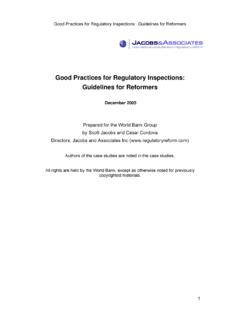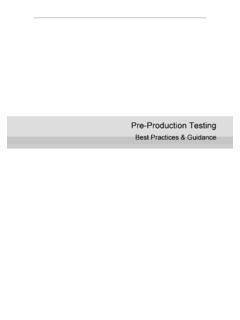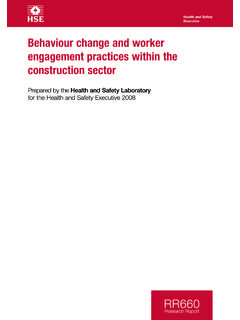Transcription of Microbiology Proficiency Testing Best Practices
1 PracticesMicrobiology Proficiency Testing2 Phenova | Tel: 866-942-2978 | Fax: 866-283-0269 | Email: | Web: more information 2015 Phenova, Inc. All rights , Pour, and Go withWhole Volume Microbiological Standards Supplying your laboratory with a whole volume format provides PT standards that by design most accurately represents an everyday field sample, with a microbiological culture already cultivated in media. Easy To UseNo Preparation NeededRealisticPresented and Accurate As Any Other Field Sample Saves TimeSkip The Rehydration Step and Expedite Your Analysis TimeError FreeEliminate Possible Dilution Errors and Avoid Mis-Labeling with Extra Labels3 Phenova | Tel: 866-942-2978 | Fax: 866-283-0269 | Email: | Web: of ContentsOpen, Pour, and Go withWhole Volume Microbiological Standards Phenova s Guide helps define the best Practices and guidelines to undertake when your laboratory is performing a Microbiological Proficiency Testing (PT) Study.
2 Sample Preparation ..4 Media Preparation ..5 Analysis and Handling ..6 Filter Paper ..7 Incubation ..8 Colony Counting ..9 Lab Equipment ..9 How to Troubleshoot Effectively ..10 Microbiological QC Standards ..11 The Phenova PT GuaranteeIf your lab receives a Not Acceptable result in a Phenova PT Study and cannot pinpoint the issue, contact our technical support group. We will guide you through the most effective corrective action process and, if necessary, we will provide a FREE Phenova QC Standard to help get you back on track!For Technical Support Contact PhenovaPhone: 1-866-942-2978 Email: | Tel: 866-942-2978 | Fax: 866-283-0269 | Email: | Web: PreparationThe Forgotten BeginningTemperature Allow the sample to come to room temperature before using.
3 Allow the broth, media and all reagents to come to room temperature. Make sure your incubators are at their appropriate temperatures as well. Homogenization Ensure adequate homogenization of the organism by vigorously shaking and inverting the sample prior to beginning sample analysis. Homogenize in between taking aliquots from original sample. Serial Dilutions Perform all of your serial dilutions from lowest to highest, where the concentration decreases by the same quantity in each successive step. What Does This Mean? If a dilution has a 1:10 dilution the number represents 1 part of the original sample added to 9 parts of the diluent. If you are making a series dilution from the lowest dilution ratio (1:10) to highest dilution ratio (1:100,000), then you do not need to change pipette tip in between transfer dilutions.
4 Never use Deionized (DI) Water to make dilutions, the pH may harm the organisms. A great alternative is phosphate buffer or peptone Temperature:~23 C / 74 F2 min1:109 mL broth in each tubeOriginal Inoculum1mL1mL1mL1mL1mL1:1001:1,0001:10, 0001:100,0005 Phenova | Tel: 866-942-2978 | Fax: 866-283-0269 | Email: | Web: PreparationFor Optimal GrowthCheck the following parameters to help assess and maintain the quality of your growth media. Checking the quality of your media can save you additional time and resources and prevent Testing ChecksMedia needs to be stored according to the method or manufacturer recommended temperature and light conditions. PMedia has not expired before use*PPerform Sterility Testing PTest each batch or lot with negative and positive controls (see below) PInspect media for any apparent contamination PMust be used only at room temperature P*For laboratory made media, make sure the ingredients have also not Microorganisms Standard Methods and EPA methods both note that the quality of your media should be evaluated with each new lot to ensure that the microorganisms under test are responding appropriately.
5 The best way for checking for growth supporting your analysis is with positive and negative control organisms. Positive control microorganisms are known organisms that are the same as your target organisms and provide you with typical colony formation. Negative control microorganisms need to be an organism that grows but produces an atypical colony. Remember that you can use microorganisms for 5 passes. After the 5th pass you must use a fresh incubation of the microorganism. 6 Phenova | Tel: 866-942-2978 | Fax: 866-283-0269 | Email: | Web: H20 TNIA nalysis and HandlingMicrobiological FoPT TablesAlways ensure that the filter apparatus is sterilized between sample filteringDI water can have a pH harmful to the organisms.
6 Make sure to use phosphate buffer or peptone water for the TNI FoPT tables to know the concentration range of the PT sample you are receiving. This will allow you to make the appropriate dilution filters with flamed forcepsFollow the method requirements for blanks and be sure to follow the manufacturer s instuctionsUse the entire sam-ple for dilutions and never use DI water for making dilutions, only phosphate buffer or peptone the FoPT tables at: WaterList of all approved waste water or non-potable water analytes and respective acceptance Name: NPW_FoPT-Eff WaterList of all approved drinking water analytes and respective accep-tance limits, except radiochemistry. Document Name: | Tel: 866-942-2978 | Fax: 866-283-0269 | Email: | Web: PaperUsing a 47mm; ( m) micron filter has been standard practice in microbiological methods for efficient nutrient mm Micron Pore SizeEffectiveness IndicatorsSimply place the filter over reagent water and if it sinks or the membrane wets out within 15 seconds you have a great indication of an uncompromised filter paper and proper material for the ApplicationMaintain maximum contact with the media by rolling the filter onto the media from one edge to other.
7 Minimize air bubbles forming on the filter by slowly applying the filter to the media plate. Positive ControlsQC test your filters with a positive control sample to ensure they provide a typical result. Use Phenova s QC Standards as Positive Control. (Refer to page 11.)8 Phenova | Tel: 866-942-2978 | Fax: 866-283-0269 | Email: | Web: should be contained in watertight containers and fully suspended in water bath the plates do not touch the sides of the incubator as the temperature is different than the heat sufficient time for the incubator to equilibrate when adjusting the temperature and make sure all thermometers are doors or covers should always be used properly to maintain heat capture. Be cautious for bubbles and foaming in water baths as they may affect the heat transfer and have a negative consequence on your results.
8 If necessary use a circulator or an approved de-foaming agent. Monitor the temperature twice a day to make sure it sits within your methods and organisms approved range. If you see atypical colonies, incubate another 4 hours to ensure the organism had enough time for optimal growth. Equilibration times when loading incubators and water baths need to be subtracted from the regular incubation to Look Out For 9 Phenova | Tel: 866-942-2978 | Fax: 866-283-0269 | Email: | Web: CountingIt s important to keep a trained eye when counting colonies, so that atypical colonies can be distinguished from typical colonies. Study the images below to get references as to what typical colonies look like and what to expect, however it s always best to follow any confir-mation steps in the method(s) you follow.
9 Lab EquipmentMembrane Filters Method Check that your vacuum is working correctly. Most Probable Number Method On a periodic basis check that your sealer is working properly using food dye and water. Check that your comparators are still working properly. Check that your UV light if functioning properly and providing the correct light intensity. Fecal Coliform Bacteria grown on mFC nutrient agarCircular blue colonies with different sizes and shadesTotal Coliform Bacteria grown on LES Endo nutrient agar. Circular dark red colonies with and without metallic sheenE. Coli Bacteria grown on LB nutrient agarCircular non-pigmented colonies with a shiny appearance 10 How to Troubleshoot Effectively If at any point in your PT process you come across the need to troubleshoot, the most important step is to understand the problem.
10 Taking a systematic approach to identify the root cause of the problem will be the best investment of your time/resources and it will be much easier to implement a logical solution. Corrective Action Guide Download our guide and learn how to evaluate a non-conformance or Not-Acceptable and eliminate problems Steps to a Stronger Quality Program 1. Root Cause Analysis2. Corrective Action Strategy3. Preventive Action Strategy4. Continuous ImprovementGet Your NothingMake an Educated GuessEliminateProblemsSytematicallyLearn more about QC standards. Visit at For Assistance with Incorporating QC Standards in Your Quality Program call 1-866-942-2978 or email QC StandardsWhere They Fit In Your Quality ProgramCrucial for maintaining a rigid quality management program, make QC standards a part of your practice to refine technical skills, ensure method confidence and check the integrity of laboratory protocols and Internal Quality Evaluation Verify your laboratory or instrumentation are in con-trol and meet your data quality Your Analytical Staff A powerful tool in your training regimen.









